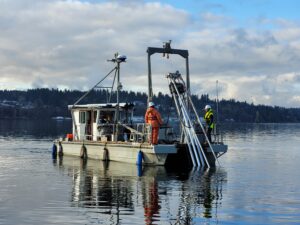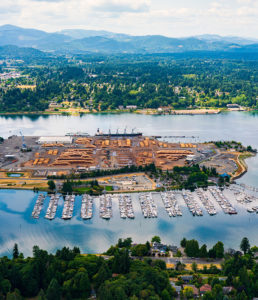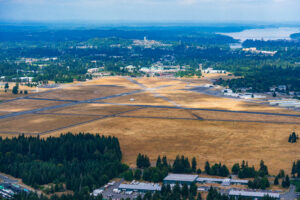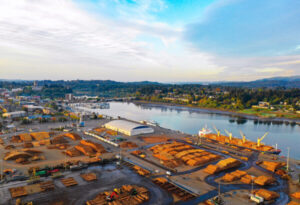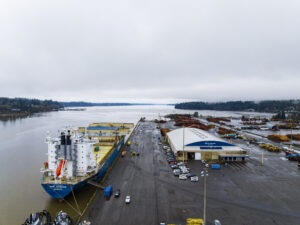Port of Olympia Blog
After months of sediment sampling and lab analysis, we’re ready to share what our marine experts have learned about contamination levels in East Bay, the site of the first phase of sediment testing in Budd Inlet.
Why We’re Testing Sediment
The Port is not the only party potentially liable for legacy pollutants in Budd Inlet. Nonetheless, under an Agreed Order with the Washington Department of Ecology, the Port has started a thorough investigation of the location and severity of contamination in Budd Inlet sediments. This means we are carefully looking at what’s in the sediment, figuring out where the contamination came from, and planning the best cleanup actions with the goal of protecting people, fish and wildlife, and improving the long-term health of Budd Inlet.
Sediment Collection Process
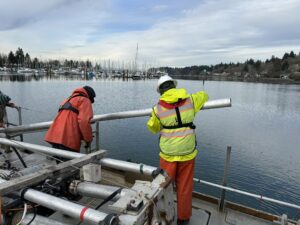
Last year, our research team spent several months collecting 1100 sediment samples from over 100 locations in East Bay as part of the Port’s investigation to determine the extent of legacy contamination in Budd Inlet from historic industries on the Port Peninsula.
The analysis of the data was extensive. Sediment samples were sent to labs in Washington and California where they were analyzed by a highly specialized team of marine experts, project consultants and scientists, followed by additional review by the Department of Ecology.
“The data tell us what contaminants are present and where they are concentrated. With this information our project team can develop a cleanup plan that is both effective and long-lasting,” said Port of Olympia Environmental Manager Jonathon Wolf, who oversees the Budd Inlet Investigation.
How We Collected Samples
Sediment samples were collected from different locations and depths to get a clear picture of sediment conditions:
- Surface samples – from the top layer of mud and debris.
- Intertidal samples – from areas exposed at low tide.
- Subsurface samples – from deeper layers below the surface.
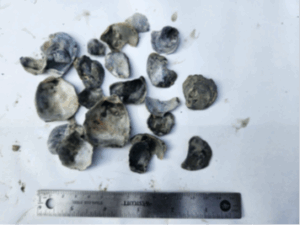
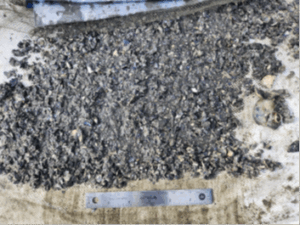
What We Found
The labs analyzed samples for a wide range of contaminants, including metals, dioxins and furans, PCBs, pesticides, and other chemicals. The findings confirm that while surface contamination seems to have improved due to natural processes and ongoing efforts by the Port, contamination is still present in deeper areas of East Bay, specifically around Moxley Creek, the navigation channel and Swantown Marina & Boatworks. Some of these locations will need active cleanup, while other areas may simply need to be monitored to ensure they recover naturally.
“While some elevated levels of contamination were found, the majority of the areas tested do not pose a major threat to marine life or human health, and should recover naturally over time,” explained Wolf. “These areas will be further clarified by our project team once we complete testing and analysis in other areas of Budd Inlet and develop a comprehensive cleanup plan.”
The Port also evaluated the results to identify possible upland sources to make sure new contamination doesn’t enter Budd Inlet in the future. This means looking at possible sources like stormwater, runoff or erosion and putting measures in place to stop them.
Key Results
Dioxins and Furans: Found in all samples; some levels were higher than Ecology screening levels.
PCBs: Found in nearly all samples, but most were below Ecology screening levels.
Metals (cadmium, arsenic, mercury): Present everywhere, though only a small percentage of samples were above state limits.
Other chemicals (like pentachlorophenol and semivolatile compounds): Rarely exceeded Ecology screening levels.
Next Steps
Sediment testing and analysis will continue in other areas of Budd Inlet through 2026. Once the sediment testing is complete, our project team will work with the Department of Ecology to develop a cleanup plan.
It is important to note that though the Port is the sole local agency conducting the investigation of Budd Inlet sediment contamination, it is expected that other liable parties will be identified during the investigation. It is the intent of the Port to ensure that all liable parties contribute to the effort and expense of the cleanup.
Based on what we know at this time, the likely cleanup actions will include:
- Dredging (removing contaminated sediment) in areas like Moxlie Creek, the navigation channel and the Marina & Boatworks area.
- Capping (placing clean material over contaminated sediment) natural recovery in areas where dredging isn’t needed.
- Exploring habitat restoration opportunities, such as at West Bay Park Lagoon.
Our Commitment to the Community
We are committed to keeping the community informed. As the project advances, we will share updates with community on our website and blog.
The Budd Inlet Cleanup is a priority for the Port of Olympia as we strive to address impacts from historical industrial operations and ensure a clean and healthy waterway for the local community, marine ecosystem and habitat.
Together, we can restore and protect Budd Inlet for future generations.

